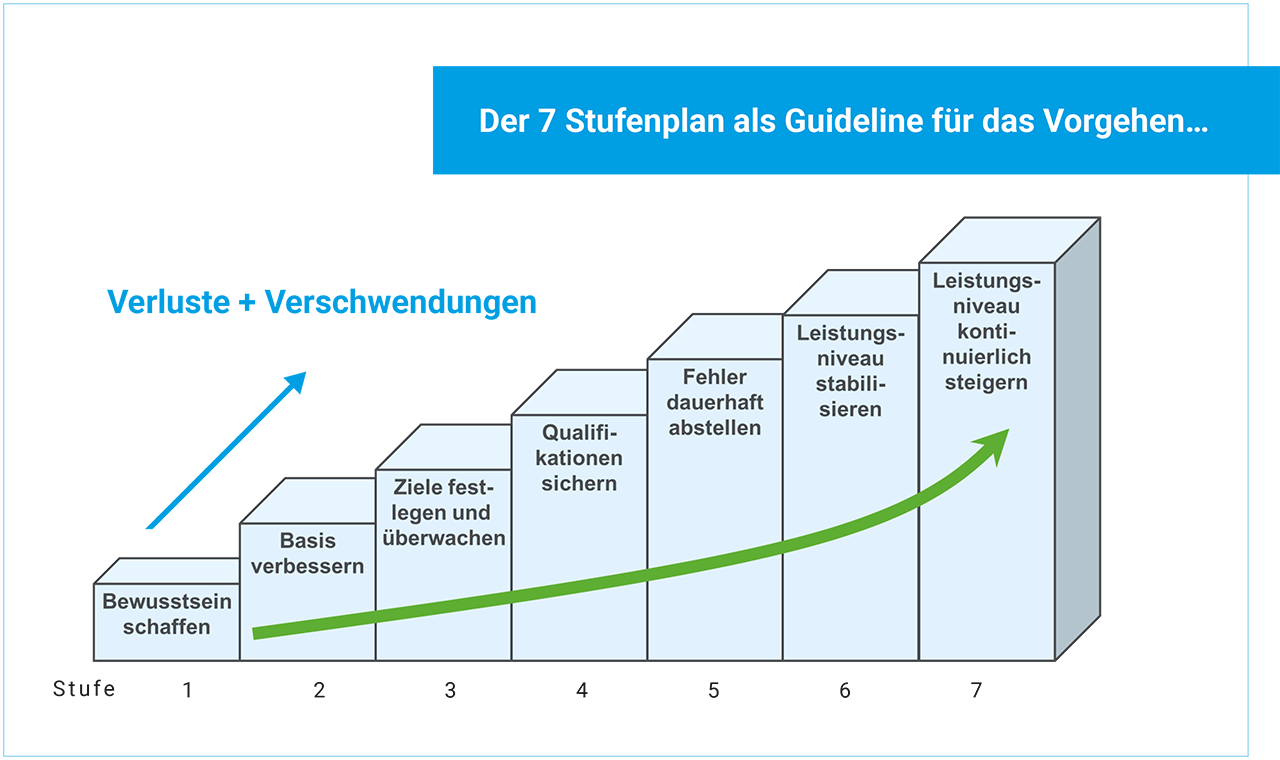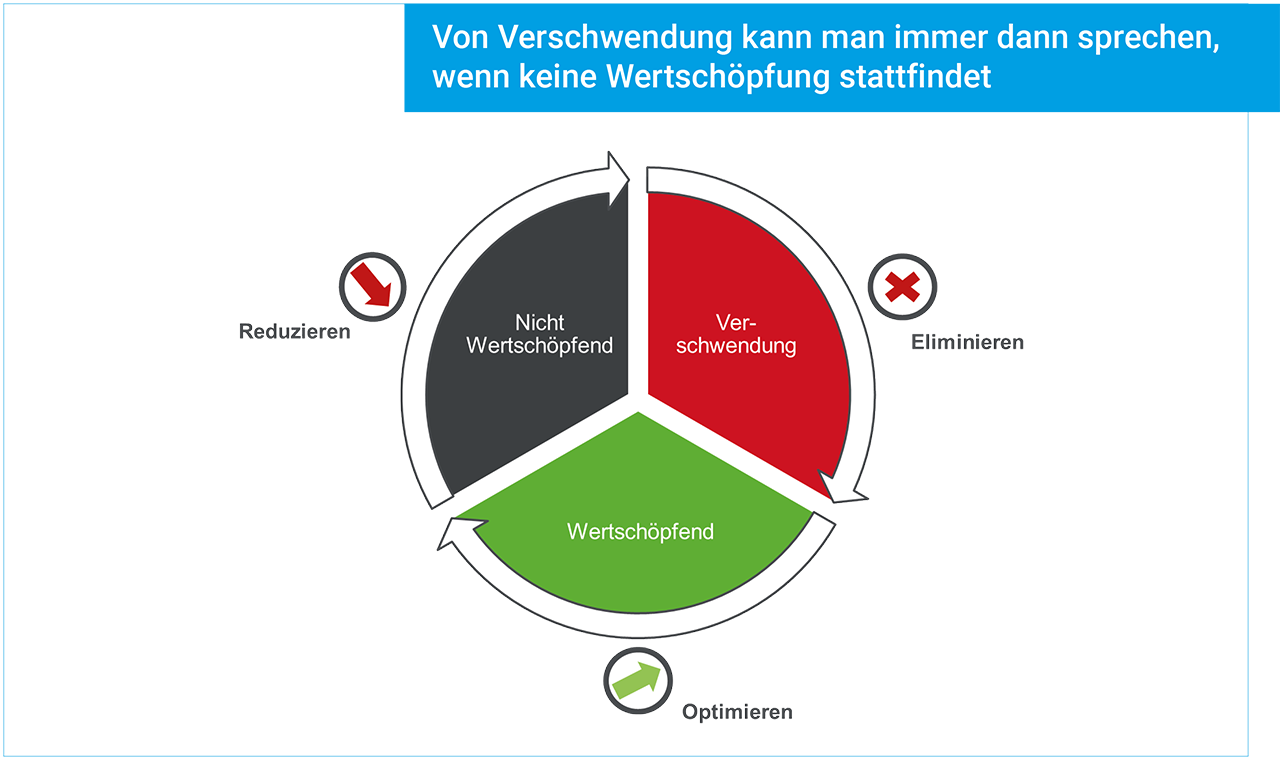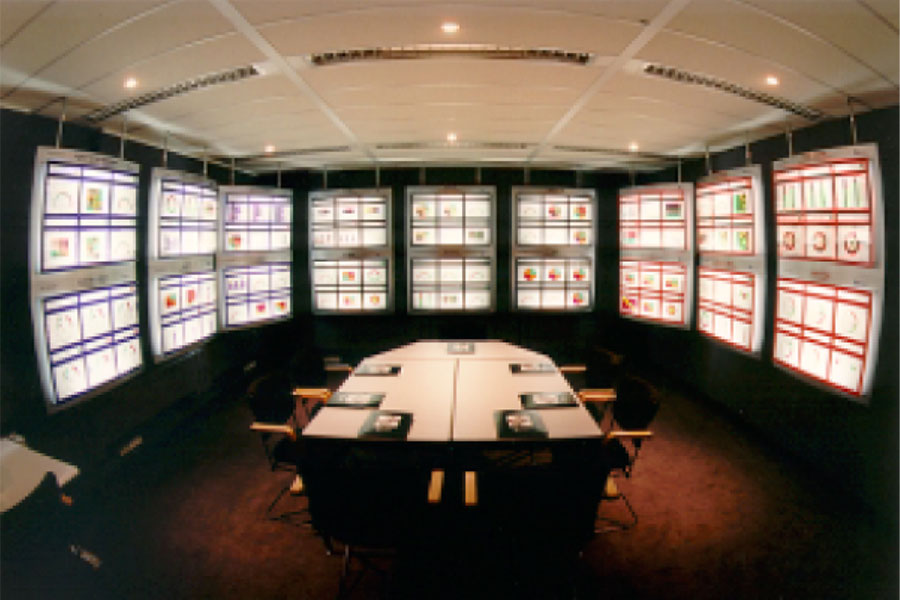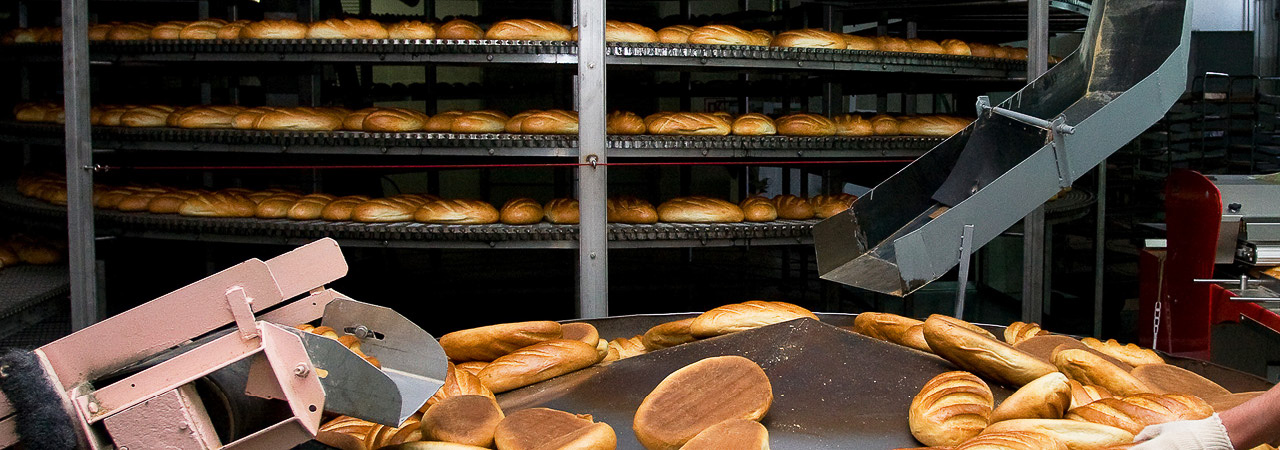Losses & wastage
Losses & wastage
Minimise through optimisation
Food Resource Management supports you in exceptional corporate situations, such as bridging management bottlenecks and implementing crisis-related reorganisation measures, through to complex project management.
Learn more
Losses & wastage
Minimise through optimisation
Food Resource Management supports you in exceptional corporate situations, such as bridging management bottlenecks and implementing crisis-related reorganisation measures, through to complex project management.
Learn more
Losses & wastage
Making the different forms “conscious
As losses and wastes are the basis for productivity losses, they need to be understood structurally. By mapping, it is easier to keep track and differentiate symptoms and causes.
We should consider whether we are fighting a symptom or a cause with what we are doing right now!


Key figures management
Key figures management
"I can only manage what I can measure!"
Food Resource Management supports you in exceptional corporate situations, such as bridging management bottlenecks and implementing crisis-related reorganisation measures, through to complex project management.
Learn more
Key figures management
"I can only manage what I can measure!"
Food Resource Management supports you in exceptional corporate situations, such as bridging management bottlenecks and implementing crisis-related reorganisation measures, through to complex project management.
Learn more
Basics & Overview
Key figure management
- Key performance indicators (KPIs) are the basis for measurable corporate success.
- I can only manage what I can measure!
- Key figures measure, analyse and control qualitative and quantitative corporate success.
What are the key figures?
In general, there are very many key figures
Key figures as an instrument
Indicators fulfil different tasks and are to be selected according to them
Indicator system
Individual key figures become a key figure system
Possible uses of key figures
Planning top-down, reporting bottom-up
Why key figures?
Identification of cause-effect relationships
Areas of application of key figures
Key figures for optimising process performance
Key figures for process analysis
Difficulty in tracking process performance
Key figures for process analysis
Neuralgic points could be identified
Key figures for process control
Achieving the goals and recognising the deviation from the previous trend
Advantages of the GAE indicator
GAE offers many advantages over other key figures
Visualisation
The result should be a clear cockpit chart
Visualisation on site: Example "Cockpi-Chart
Cockpit charts clearly display key figures


Visualisation on site:
Different types of viualisation serve different goals
Lean Management
Lean Management
Reduce costs sustainably to increase company profits
Food Resource Management supports you in exceptional corporate situations, such as bridging management bottlenecks and implementing crisis-related reorganisation measures, through to complex project management.
Learn more
Lean Management
Reduce costs sustainably to increase company profits
Food Resource Management supports you in exceptional corporate situations, such as bridging management bottlenecks and implementing crisis-related reorganisation measures, through to complex project management.
Learn more
Reducing costs along the value chain
Act efficiently
Lean management focuses on minimising your waste to reduce costs, shorten process flows in the value chain and avoid errors – while striving for the best possible quality.
The goals of lean management are to achieve 100% customer satisfaction at the lowest possible cost. This means that the maximum value for the customer’s money should be achieved with a minimum use of personnel, time and investment.
But what concrete advantages does your company gain from lean management, or what is its core? Creating a corporate culture that does not directly condemn mistakes but sees them as an opportunity. – The avoidance of waste and the resulting increase in value creation along your supply chain can be managed well using well-known lean methods.
If I ask a supply chain manager whether the customer is satisfied and the answer is: “The customer gets 100% of the goods in the desired quality at the desired time – yes, the customer is satisfied! This is exactly where LEAN MANAGEMENT comes in! But before I reduce stocks, I should make sure that my set-up times do not increase. Smaller batch sizes and, as a result, more frequent format and product changes generate a productivity loss of almost 30% and thus lead to significant cost increases in production.
Typical observation
Lean Management
- excessive set-up and cleaning times
- unplanned downtimes caused by technical failures or communication problems
- Quality fluctuations
- Reduction of throughput times
- Performance and efficiency problems
- Raw material wastage > 2%
- Achieving 100% delivery capability
- Identifying losses and wastage
Effective construction kit
Take action
- 1. The overall equipment efficiency GAE or OEE which describes the technical availability of the equipment.
- 2. The continuous improvement process CIP, which identifies all potential for improvement overarching.
- 3. The ISHIKAWA process which brings together causes and solutions.
- 4. The 5x Why Analysis – After 5 x Why questions you usually have the cause!
- 5. The value stream analysis or value stream design along your supply chain.
- However, sustainable lean management also requires effective CHANGE MANAGEMENT.
- The framework for the measures is quickly established. But it is your employees who will implement it.
- A functioning CHANGE MANAGEMENT gets your employees to believe that the changes are wanted and not needed.
– see also video Change Management
A good investment for your company!
Food Resource Management GmbH assures you of a productivity increase of at least 5% with LEAN and CHANGE MANAGEMENT! Together with you, we develop a customised programme, control and monitor the process steps and ensure sustainable success.
Set-up time reduction
Set-up time reduction
In 8 steps to set-up time 0
Food Resource Management supports you in exceptional corporate situations, such as bridging management bottlenecks and implementing crisis-related reorganisation measures, through to complex project management.
Learn more
Set-up time reduction
In 8 steps to set-up time 0
Food Resource Management supports you in exceptional corporate situations, such as bridging management bottlenecks and implementing crisis-related reorganisation measures, through to complex project management.
Learn more
Set-up times
Better & More Efficient
Our machines must become even better and more efficient! – This is a typical thinking of many entrepreneurs when it comes to increasing profitability in their production operations. At the same time, however, many companies often accept long set-up times and the associated disadvantages such as high batch sizes and inventories, low flexibility and, of course, downtimes. And it is precisely here that there is great potential for savings: set-up processes take up a highly underestimated part of the production processes and thus also of the costs, because during set-up times, production comes to a standstill – and standstill is time during which no money is earned.
Aim of the optimisation
Reduction, avoidance, control
- The variety of products has increased considerably in the past.
- Customers therefore order the items they need in smaller batches.
- In order to respond to these demands, batch sizes must be continuously reduced.
- Conversely, this means that flexible and fast changeover is required for the production of the various articles.
- Since a set-up process involves losses in availability, it is important to keep these set-up processes as short as possible in terms of time.
Set-up time reduction
Customise the operations
Basically, in Lean Management, set-up is considered a waste, as it is idle time that does not add value and must be minimised as much as possible. Here we look at the number and duration of set-up processes. Every unscheduled setup costs planned production time, which results in significant productivity losses. How often are unscheduled changes to production plans made in your company? This is where set-up matrices come into play, creating an awareness of the optimal set-up sequence. The set-up time is divided into internal set-up time (that is, time portions of the set-up that can only be done when the machine is at a standstill, such as changing a film roll) and external set-up time (time portions of the set-up that can also be done when the machine is running).
Set-up workshop
Customised solutions
We uncover your hidden potential for cost reduction through set-up time optimisation! The targeted reduction of these set-up times can reduce downtimes due to machine stoppages by up to 60 percent, saving your company time and money. On top of that, the production processes become much more flexible and enable your company to produce small batch sizes or make more frequent product changes. This more flexible plant utilisation gives your company a major competitive advantage. In a practice-oriented workshop, your employees will receive the “tools” to reduce set-up times in your company at the same time. 40% set-up time optimisation after 1 week is easily possible. Fast set-up – the eight steps to “zero” set-up time.
Processes
Reduce set-up time by 60%
- Record actual state
- Carry out 5S action
- Standardise processes
- Separate internal and external set-up
- Shift activities to external set-up
- Shorten internal set-up times
- Reduce external set-up times
- Repeat steps 4-7 constantly
Practical example
Investment for your company
At a renowned processor of meat products with a turnover of 120 m€, the set-up time was reduced by 40% within 4 weeks …and after another 4 weeks by a total of 60%. The bottom line was that this resulted in a productivity increase of 1m€/year, confirmed by the controlling, only through optimisation of set-up time. This was achieved in 3 months and consolidated as a permanent process! But what can we offer YOU? Within 2-4 weeks your company can already reduce set-up times by 40% through steps 1-4. This happens through awareness and observation alone.
Business Mediation
Business Mediation
Conflicts are opportunities -tools for avoiding conflicts in your company
Professional conversation and conflict management
Thu 26 Jan. 2023 / 11 am to 12 pm
In the daily dialogue with employees, a multitude of different discussion situations arise that the manager or the key figure (multiplier) has to deal with.
Join Zoom Meeting
Meeting-ID: 830 4682 0663
Kenncode: JYvQ5F
Contents & Challenges
In the daily dialogue with employees, a multitude of different discussion situations arise that the manager or the key figure (multiplier) has to deal with. This workshop raises awareness of these discussion situations and also helps to better resolve possible conflicts. Conducting conversations at work is an important component in order to be able to act successfully. It is necessary to meet the counterpart at eye level and to respond to the interlocutor.
If it is an appraisal interview, the responsibility lies primarily with the supervisor, but the employee also shares some of the responsibility for a successful interview. During such a discussion, both parties enter into a face-to-face dialogue in which it is important to be open, honest and willing to engage with the other person’s perspective.
But conversations with customers and service providers also follow certain standards. A balanced conversation serves to find out which interests, needs or special topics are important for the conversation partner. Active listening is of enormous importance in every conversation. This can be signalled to the conversation partner in several ways, for example through eye contact, nodding or short words. Questions also signal interest, which is positively noticed by the counterpart.
What good is that going to do me?
- Conduct more efficient conversations
- Persuade more quickly
- Not letting arguments get out of hand in discussions
- Persuade others in a way that they do not feel persuaded
- Influence others without it being noticeable
- Not to have unproductive conversations
- Learn to listen better
- To improve my own communication behaviour
Why you should think about business mediation!
- Running a business is demanding.
- You need to think about a strategy to maintain and grow your business.
- They have to manage the daily operations and manage staff.
- Do you face customers, sign contracts, offer after-sales services?
But in some cases (fortunately not too often) disputes arise either with a staff member, between staff members, with a customer or a supplier.
What to do in business disputes? How can you act as a leader and protect your company at the same time?
Remember, a good lawyer/advocate will always be at your side. But you may ask yourself:
- What is best for me: go to court or find an alternative dispute resolution procedure?
Let’s see what business mediation can do for you to resolve these conflicts. It could save you money, time and cause much less stress.
What does mediation mean for your company?
- Mediation can help you settle your business dispute out of court.
- Mediation is, at its core, a voluntary process in which a neutral third party – the mediator – guides two or more parties to a dispute through their conflict. The purpose of this semi-formal process is to ensure that the concerns of all parties are heard so that they can develop their own solution in a productive dialogue.
- Retaining the power to control the outcome of the conflict is just one of many advantages mediation has over litigation. It also saves time and money, is less adversarial, confidential and structured to maintain relationships and prevent recurrences.
- The result of mediation is a written, signed agreement in which all parties agree to be the most mutually beneficial solution.
How does business mediation work?
- Mediation is voluntary, so the first step in the process is to get both parties to agree to participate. Once mediation has been chosen as the preferred method of conflict resolution, both parties must jointly decide on a mediator.
- While all mediators have their own style, the basic structure of mediation is uniform.
- Before the first mediation session is arranged, the mediator must be informed, either by asking both sides to prepare a written summary of the situation for review, or by arranging individual meetings with each party to discuss the background.
- Once the details are gathered, a meeting is scheduled at a neutral location . This can be a boardroom, an office or even a virtual meeting room. Before the session begins, the mediator gives an overview of the process so that everyone knows what to expect.
- Then each party and/or its counsel will be given the opportunity to make opening statements.
- Even though the relationship may be strained, the right business mediator will be able to get both parties to communicate with each other and identify common goals to reach an amicable solution.

Business Mediation
Conflicts are opportunities -tools for avoiding conflicts in your company
Professional conversation and conflict management
Thu 26 Jan. 2023 / 11 am to 12 pm
In the daily dialogue with employees, a multitude of different discussion situations arise that the manager or the key figure (multiplier) has to deal with.
Join Zoom Meeting
Meeting-ID: 830 4682 0663
Kenncode: JYvQ5F
Contents & Challenges
In the daily dialogue with employees, a multitude of different discussion situations arise that the manager or the key figure (multiplier) has to deal with. This workshop raises awareness of these discussion situations and also helps to better resolve possible conflicts. Conducting conversations at work is an important component in order to be able to act successfully. It is necessary to meet the counterpart at eye level and to respond to the interlocutor.
If it is an appraisal interview, the responsibility lies primarily with the supervisor, but the employee also shares some of the responsibility for a successful interview. During such a discussion, both parties enter into a face-to-face dialogue in which it is important to be open, honest and willing to engage with the other person’s perspective.
But conversations with customers and service providers also follow certain standards. A balanced conversation serves to find out which interests, needs or special topics are important for the conversation partner. Active listening is of enormous importance in every conversation. This can be signalled to the conversation partner in several ways, for example through eye contact, nodding or short words. Questions also signal interest, which is positively noticed by the counterpart.
What good is that going to do me?
- Conduct more efficient conversations
- Persuade more quickly
- Not letting arguments get out of hand in discussions
- Persuade others in a way that they do not feel persuaded
- Influence others without it being noticeable
- Not to have unproductive conversations
- Learn to listen better
- To improve my own communication behaviour
Why you should think about business mediation!
- Running a business is demanding.
- You need to think about a strategy to maintain and grow your business.
- They have to manage the daily operations and manage staff.
- Do you face customers, sign contracts, offer after-sales services?
But in some cases (fortunately not too often) disputes arise either with a staff member, between staff members, with a customer or a supplier.
What to do in business disputes? How can you act as a leader and protect your company at the same time?
Remember, a good lawyer/advocate will always be at your side. But you may ask yourself:
- What is best for me: go to court or find an alternative dispute resolution procedure?
Let’s see what business mediation can do for you to resolve these conflicts. It could save you money, time and cause much less stress.
What does mediation mean for your company?
- Mediation can help you settle your business dispute out of court.
- Mediation is, at its core, a voluntary process in which a neutral third party – the mediator – guides two or more parties to a dispute through their conflict. The purpose of this semi-formal process is to ensure that the concerns of all parties are heard so that they can develop their own solution in a productive dialogue.
- Retaining the power to control the outcome of the conflict is just one of many advantages mediation has over litigation. It also saves time and money, is less adversarial, confidential and structured to maintain relationships and prevent recurrences.
- The result of mediation is a written, signed agreement in which all parties agree to be the most mutually beneficial solution.
How does business mediation work?
- Mediation is voluntary, so the first step in the process is to get both parties to agree to participate. Once mediation has been chosen as the preferred method of conflict resolution, both parties must jointly decide on a mediator.
- While all mediators have their own style, the basic structure of mediation is uniform.
- Before the first mediation session is arranged, the mediator must be informed, either by asking both sides to prepare a written summary of the situation for review, or by arranging individual meetings with each party to discuss the background.
- Once the details are gathered, a meeting is scheduled at a neutral location . This can be a boardroom, an office or even a virtual meeting room. Before the session begins, the mediator gives an overview of the process so that everyone knows what to expect.
- Then each party and/or its counsel will be given the opportunity to make opening statements.
- Even though the relationship may be strained, the right business mediator will be able to get both parties to communicate with each other and identify common goals to reach an amicable solution.

Leadership development
Leadership development
Empower your employees to take responsibility with visible results
Food Resource Management supports you in exceptional corporate situations, such as bridging management bottlenecks and implementing crisis-related reorganisation measures, through to complex project management.
Learn more
Leadership development
Empower your employees to take responsibility with visible results
Food Resource Management supports you in exceptional corporate situations, such as bridging management bottlenecks and implementing crisis-related reorganisation measures, through to complex project management.
Learn more
Recognise potentials
Coaching for your managers
The right selection and the continuous development and mentoring of leaders is the key responsibility of top management.
The conventional approaches of methods and techniques alone are no longer sufficient by far. Increasingly, it is necessary to define values with managers and to recognise and specifically promote their individual personalities.
Only with a holistic approach will demanding managers be adequately looked after and motivated in the future. Only managers who are well looked after and motivated will ensure the company’s success.
Our successfully applied development programme is based precisely on this holistic approach. In addition to teaching important skills and methods for leadership and management, the development of one’s own personality plays a central role. In this way, managers are not only well trained but also confidently balanced. Fit for the individual requirements of today and tomorrow.
In close and transparent cooperation with the management, individual goals are set and progress is verified together on a regular basis.
Individual progress is supported by accompanying coaching. In addition, the exchange with other managers in mixed groups offers the opportunity to efficiently expand one’s own network and enables one to look beyond one’s own nose.
365 Days Master Plan
A good investment for your company
Practical example
A proven cross-plant lean management system was introduced at a manufacturer of starch products in Austria:
- Targeted stocktaking and definition of individual development fields and goals.
- Open learning coalition between manager, supervisor and trainer/coach.
- Accompanying individual coaching provides targeted support and addresses personal issues.
- A multi-level seminar programme imparts knowledge and skills for leadership and management. The “Personal Mastery” element supports the path to becoming an authentic leader.
- With the specially developed app technology, the development is continuously verified.
Leadership development is also one of the most important factors for the future of your company. Our seminar programme will convince you – tailor-made for your needs.
Bookable as a holistic annual programme or individual modules or coaching. We will be happy to answer your questions and present the programme to you personally. When do we want to start? From us immediately.
With our support, we will not only answer the most important questions, but offer you a way to start training your leaders immediately.
Company succession
Company succession
Initiate the continuation of your business wisely
Food Resource Management supports you in exceptional corporate situations, such as bridging management bottlenecks and implementing crisis-related reorganisation measures, through to complex project management.
Learn more
Company succession
Initiate the continuation of your business wisely
Food Resource Management supports you in exceptional corporate situations, such as bridging management bottlenecks and implementing crisis-related reorganisation measures, through to complex project management.
Learn more
Thinking for generations
Settle company succession
Change of entrepreneurial responsibility: Company succession is a drastic step for both sides. The transferor hands over his company, his life’s work. In a mirror image, the successor enters a new phase of life with the takeover. Good preparation is the key to success.

But we also provide support in the areas of marketing and sales as well as financial planning. It is also important to consider whether a change in the legal form of your company should be considered from a tax perspective before the sale. If you are aiming for a company succession within the family, we will also support you in this transfer, taking into account the current inheritance tax consequences.
Service contents (excerpt)
Evaluation & Support
We value your company to create maximum transparency for you and thereby determine a fair purchase price for both sides. We provide the right contacts and prepare you for your immediate business succession! We can also offer our help in researching funding. Together we prepare a market analysis to assess the potential. This includes:
- Sales volume
- Sales potential
- Market volume
- Market potential
We analyse the competitive situation together.
We do a location analysis, because access to raw materials can depend on the choice of location. The actual location of the company is crucial from the very beginning and touches all important factors of a business concept:
target group, suppliers, competitors, personnel, costs, transport connections and infrastructure.Due to our experience as interim managers, we can accompany the structural change internally.
The accessibility of your company for customers and suppliers must be ensured. The level of rental costs is equally important. From the outset, weigh up what requirements you have for the location and what you can spend on it.
Value chain analysis
Value chain analysis
Analysis of the added value of your business activities
Sustainable corporate optimisation
Analyse fields of action
Food Resource Management is an experienced specialist in the critical analysis of complex value chains. We analyse all relevant fields of action step by step. This enables you to accurately evaluate your corporate activities with regard to the effectiveness and efficiency of the value-added processes, to tap unused potential and resources and to realise a cost advantage in the market. We develop implementation-oriented, holistic and process-oriented concepts for you to increase your overall efficiency and, if desired, accompany you during their implementation.
Areas of application
Added value through process optimisation
From reducing the use of raw materials by optimising strategic or operational purchasing or increasing productivity by increasing machine availability to eliminating bottlenecks by analysing weak points in the production process. Our results help you in the context of strategic decisions and secure your competitive advantage in the market.
- Cost and schedule controlling
- Key figure management and control
- Personnel costs / productivity
- Receivables and liabilities
- Sales deductions
- Examination of the material costs
- Designing the purchasing strategy (operational and strategic)
- Supplier evaluation
- Negotiation of prices and conditions
- Tendering of new contracts
- Design and conclusion of contracts
- Review of staff qualification
- Staff scheduling
- Outsourcing of service areas
- Development of performance-related key performance indicators
- Coaching and temporary staff management
- Staff turnover, sickness rate
- Audits, HACCP, certifications (IFS, BRC, Kosher)
- Complaints, traceability
- Analysis of waste quantities
- Use of rework
- Implementation of step controls
- Analysis of blockages
- Conceptual hygiene tours
- Cross-divisional coordination of development activities
- Development of new products
- Expenditure evaluations for developments
- Project and investment cost planning
- Analysis of the productivity ratios
- Evaluation of downtimes
- Review of set-up and cleaning times
- Optimisation of the employee deployment rate
- Bottleneck evaluation
- Evaluation of material usage rates
- Project management / project control
- Planned maintenance system
- Repair and investment plans
- Economic efficiency calculations
- Consumption of operating materials
- EDP-controlled or chaotic warehousing
- Reduction of partial deliveries
- Optimisation of stock levels and capacity utilisation
- Optimisation of fleet costs
- Reduction of acceptance refusals
- Optimisation of outsourcing costs
- Analyse der Geschäfts- und Marketingstrategie
- Entwicklung eines Vertriebs- und Marketingkonzeptes
- Sortimentsstraffung und Lieferfähigkeit
- Optimierung des Produktportfolios
- Erstellung von Marketingplänen
- Sustainable optimisation of packaging and packaging processes
- Specialist in the management of industrial data communication
- Partner for restructuring and project management
- Optimal production processes in costs and efficiency
- Preparation of a business valuation in which we present your company in clear terms and with meaningful figures. A presentation of strengths and weaknesses from the external perspective of experienced experts.
- We arrange value chain analyses, real estate and acquire equity capital.
Efficient value chain analysis
Analyse fields of action
- With an analysis of your value chain, you can closely examine your business activities in terms of effectiveness and efficiency of the flow processes.
- Food Resource Management is an experienced specialist in the critical analysis of complex value chains.
- We analyse all relevant fields of action step by step. We record your resources, present you with possible optimisation approaches and, if desired, accompany their implementation: from reducing the use of raw materials by optimising strategic or operational purchasing or increasing productivity by increasing machine availability to eliminating bottlenecks by analysing weak points in the production process. Our results help you in the context of strategic decisions and secure your competitive advantage in the market.
- “The only constant in the universe is change.” Heraclitus of Ephesus, (c. 540 – 480 BC), we work with you to develop optimal solutions and support you reliably and competently in the implementation of projects at both strategic and operational levels through holistic management.
- We know the markets and the new technologies and focus on innovative and practical advice. Convince yourself!
We open up new solution spaces and perspectives
Food Resource Management is an internationally operating specialist for professional management in the food industry.
With our following core areas, we cover the complete range of consulting-relevant topics in the food industry:
-
Interim Management
Vacancy Bridging and Restructuring
-
Project Management
Realisation of your projects in planning, implementation, management and control
-
Business valuation
Analysis and evaluation of your company structures
-
Value chain analysis
Analysis of the added value of your business activities
-
Company succession
Initiate the continuation of your business wisely
-
Change Management
Planned management of change processes from the actual to the target state
-
Leadership development
Empowering your leaders to be accountable and making that visible through results
-
Business Mediation
Conflicts are opportunities -tools for avoiding conflicts in your company
-
Set-up time reduction
In 8 steps to set-up time 0
-
Lean Management
Reduce costs sustainably to increase company profits
In accordance with our principle “Every customer is unique” we develop optimisation approaches together with you and accompany their implementation on request: from reducing the use of raw materials by optimising strategic or operational purchasing or increasing productivity by increasing machine availability to eliminating bottlenecks by analysing weak points in the production process. Our results help you in the context of strategic decisions and secure your competitive advantage in the market.

Solutions for demanding tasks
Case studies from practice
Example 1
Analysis of the value chain in the largest slaughterhouse in Ethiopia (project duration 12 months)

The slaughter rate for European cattle is about 80%, whereas in Ethiopian slaughter culture it is only 42%. Through coordinated training measures, the slaughter rate could be increased by 25% in a first step. As a result, meat from Ethiopia is now more competitive in international trade.
Example 2
Analysis of the value chain in a factory for processing bamboo into floor coverings and toothpicks in Ethiopia (project duration 3 months)

Bamboo has a possible water content of more than 80% after water storage. Since this raw material is paid for by weight, it is often watered by suppliers to the bamboo processing industry. For the production of flooring or toothpicks, however, the water content alone must not exceed 8%, which is achieved by using complex steam drying technology. Furthermore, by implementing water testing procedures for bamboo, it was possible to prevent the water content from rising above 30% before delivery. The operating result was improved by 17% through the reduction of energetic steam drying and the 40% reduction in the use of raw materials.
Example 3
Outsourcing of the packaging and shipping department at a bakery manufacturer as part of the value chain analysis and personnel cost reduction (project duration 2 months)

At a bakery manufacturer, personnel costs amounted to more than 43%. In order to avert a pending insolvency, these had to be reduced by at least 10%. Since the previous logistics and shipping processes had proven to be unproductive, an external service company was founded and the logistics and shipping area was outsourced. In a first step, this resulted in a 7% reduction in personnel costs and plant productivity was also increased by 4%.
Value chain analysis
Analysis of the added value of your business activities
Sustainable corporate optimisation
Analyse fields of action
Food Resource Management is an experienced specialist in the critical analysis of complex value chains. We analyse all relevant fields of action step by step. This enables you to accurately evaluate your corporate activities with regard to the effectiveness and efficiency of the value-added processes, to tap unused potential and resources and to realise a cost advantage in the market. We develop implementation-oriented, holistic and process-oriented concepts for you to increase your overall efficiency and, if desired, accompany you during their implementation.
Areas of application
Added value through process optimisation
From reducing the use of raw materials by optimising strategic or operational purchasing or increasing productivity by increasing machine availability to eliminating bottlenecks by analysing weak points in the production process. Our results help you in the context of strategic decisions and secure your competitive advantage in the market.
- Cost and schedule controlling
- Key figure management and control
- Personnel costs / productivity
- Receivables and liabilities
- Sales deductions
- Examination of the material costs
- Designing the purchasing strategy (operational and strategic)
- Supplier evaluation
- Negotiation of prices and conditions
- Tendering of new contracts
- Design and conclusion of contracts
- Review of staff qualification
- Staff scheduling
- Outsourcing of service areas
- Development of performance-related key performance indicators
- Coaching and temporary staff management
- Staff turnover, sickness rate
- Audits, HACCP, certifications (IFS, BRC, Kosher)
- Complaints, traceability
- Analysis of waste quantities
- Use of rework
- Implementation of step controls
- Analysis of blockages
- Conceptual hygiene tours
- Cross-divisional coordination of development activities
- Development of new products
- Expenditure evaluations for developments
- Project and investment cost planning
- Analysis of the productivity ratios
- Evaluation of downtimes
- Review of set-up and cleaning times
- Optimisation of the employee deployment rate
- Bottleneck evaluation
- Evaluation of material usage rates
- Project management / project control
- Planned maintenance system
- Repair and investment plans
- Economic efficiency calculations
- Consumption of operating materials
- EDP-controlled or chaotic warehousing
- Reduction of partial deliveries
- Optimisation of stock levels and capacity utilisation
- Optimisation of fleet costs
- Reduction of acceptance refusals
- Optimisation of outsourcing costs
- Analysis of the business and marketing strategy
- Development of a sales and marketing concept
- Streamlining of the product range and delivery capability
- Optimisation of the product portfolio
- Preparation of marketing plans
- Sustainable optimisation of packaging and packaging processes
- Specialist in the management of industrial data communication
- Partner for restructuring and project management
- Optimal production processes in costs and efficiency
- Preparation of a business valuation in which we present your company in clear terms and with meaningful figures. A presentation of strengths and weaknesses from the external perspective of experienced experts.
- We arrange value chain analyses, real estate and acquire equity capital.
Efficient value chain analysis
Analyse fields of action
- With an analysis of your value chain, you can closely examine your business activities in terms of effectiveness and efficiency of the flow processes.
- Food Resource Management is an experienced specialist in the critical analysis of complex value chains.
- We analyse all relevant fields of action step by step. We record your resources, present you with possible optimisation approaches and, if desired, accompany their implementation: from reducing the use of raw materials by optimising strategic or operational purchasing or increasing productivity by increasing machine availability to eliminating bottlenecks by analysing weak points in the production process. Our results help you in the context of strategic decisions and secure your competitive advantage in the market.
- “The only constant in the universe is change.” Heraclitus of Ephesus, (c. 540 – 480 BC), we work with you to develop optimal solutions and support you reliably and competently in the implementation of projects at both strategic and operational levels through holistic management.
- We know the markets and the new technologies and focus on innovative and practical advice. Convince yourself!
We open up new solution spaces and perspectives
Food Resource Management is an internationally operating specialist for professional management in the food industry.
With our following core areas, we cover the complete range of consulting-relevant topics in the food industry:
-
Interim Management
Vacancy Bridging and Restructuring
-
Project Management
Realisation of your projects in planning, implementation, management and control
-
Business valuation
Analysis and evaluation of your company structures
-
Value chain analysis
Analysis of the added value of your business activities
-
Company succession
Initiate the continuation of your business wisely
-
Change Management
Planned management of change processes from the actual to the target state
-
Leadership development
Empowering your leaders to be accountable and making that visible through results
-
Business Mediation
Conflicts are opportunities -tools for avoiding conflicts in your company
-
Set-up time reduction
In 8 steps to set-up time 0
-
Lean Management
Reduce costs sustainably to increase company profits
In accordance with our principle “Every customer is unique” we develop optimisation approaches together with you and accompany their implementation on request: from reducing the use of raw materials by optimising strategic or operational purchasing or increasing productivity by increasing machine availability to eliminating bottlenecks by analysing weak points in the production process. Our results help you in the context of strategic decisions and secure your competitive advantage in the market.

Solutions for demanding tasks
Case studies from practice
Example 1
Analysis of the value chain in the largest slaughterhouse in Ethiopia (project duration 12 months)

The slaughter rate for European cattle is about 80%, whereas in Ethiopian slaughter culture it is only 42%. Through coordinated training measures, the slaughter rate could be increased by 25% in a first step. As a result, meat from Ethiopia is now more competitive in international trade.
Example 2
Analysis of the value chain in a factory for processing bamboo into floor coverings and toothpicks in Ethiopia (project duration 3 months)

Bamboo has a possible water content of more than 80% after water storage. Since this raw material is paid for by weight, it is often watered by suppliers to the bamboo processing industry. For the production of flooring or toothpicks, however, the water content alone must not exceed 8%, which is achieved by using complex steam drying technology. Furthermore, by implementing water testing procedures for bamboo, it was possible to prevent the water content from rising above 30% before delivery. The operating result was improved by 17% through the reduction of energetic steam drying and the 40% reduction in the use of raw materials.
Example 3
Outsourcing of the packaging and shipping department at a bakery manufacturer as part of the value chain analysis and personnel cost reduction (project duration 2 months)

At a bakery manufacturer, personnel costs amounted to more than 43%. In order to avert a pending insolvency, these had to be reduced by at least 10%. Since the previous logistics and shipping processes had proven to be unproductive, an external service company was founded and the logistics and shipping area was outsourced. In a first step, this resulted in a 7% reduction in personnel costs and plant productivity was also increased by 4%.
Change Management
Change Management
Planned management of change processes from the actual to the target state
Food Resource Management supports you in exceptional corporate situations, such as bridging management bottlenecks and implementing crisis-related reorganisation measures, through to complex project management.
Learn more
Change Management
Planned management of change processes from the actual to the target state
Food Resource Management supports you in exceptional corporate situations, such as bridging management bottlenecks and implementing crisis-related reorganisation measures, through to complex project management.
Learn more
Processes of change
Reach goals
Our experienced interim managers work hand in hand with you to design the necessary change process, including the individual measures and accompanying communication. Together with you and your teams, we develop, control and monitor the process steps and ensure sustainable success. Fundamental risks for the success of change projects usually exist due to deficits in:
- Communication
- Understanding of roles
- Targets
Employees are more likely to identify with goals if they are actively involved, genuinely participate in the problem and solution strategies. Our role as experienced mentors significantly influences this process. This concerns not only the question of the extent to which the actors affected by change have different ideas about the goals and means of change, but also whether they want organisational change at all. It is easy to say that the only constant in organisations today is change. How to shape change successfully, however, is much more difficult to answer. We see successful change management as the right mix of four components:
1. Agree goals
2. Inform
3. Participate
4. Qualify
It is important to find the right mix for the respective organisation in each phase of the change process. To do this, the current state of the organisation must be assessed again and again. Change management is therefore a chain of diagnostic and intervention loops with the aim of continuously monitoring and controlling the change process.

Practical example
Lean Management
At a starch product manufacturer in Austria, a proven cross-plant lean management system was introduced. The framework for this process was quickly established.
However, before the new system could be taken up and lived by the staff, the corporate goals and the responsibilities of each individual had to be worked out and redefined.
In principle, the framework of this process is set up very quickly. However, before the new system is lived by the employees and also implemented in their minds, depends on the prepared and accompanying change management.
If such a change process of system change is not or insufficiently prepared, the acceptance of the employees will only be achieved in a very tough and protracted way. A failure of the process combined with the failure to achieve the important goals is then often the result.
Change management in this case also means preparation for what is coming or this new lean process that changes the corporate culture. i.e. the employees should want the new lean concept because it helps them and not because the management or the board wants it.
If this change process is not successful, for many employees this lean process is just the “new sow being herded through the village”.
Practical example of the procedure at a renowned starch producer:
The management and the board of directors present the planned process on the intranet, in the company newspapers and on notice boards.
The works council was involved from the beginning.
Key players in the process were defined with whom project goals were jointly defined.
Monthly status reports on the Lean process were distributed to all staff.
All employees concerned were actively involved and trained in all topics.
The commitment of the management and the board of directors was regularly obtained and the interim goals were compared.
Business valuation
Business valuation
Analysis and evaluation of your company structures
Food Resource Management supports you in exceptional corporate situations, such as bridging management bottlenecks and implementing crisis-related reorganisation measures, through to complex project management.
Learn more
Business valuation
Analysis and evaluation of your company structures
Food Resource Management supports you in exceptional corporate situations, such as bridging management bottlenecks and implementing crisis-related reorganisation measures, through to complex project management.
Learn more
Definition of business valuation
By business valuation we mean procedures for determining the value of companies or shares in companies as well as the valuation of operating sites or business divisions. It can be carried out in decision-dependent or decision-independent situations. In the case of decision-dependent events, a change in ownership is usually intended, such as the purchase or sale of companies or parts of companies, a voluntary merger or demerger of companies, the entry of a shareholder into an existing company or a possible IPO. In the case of decision-independent events, on the other hand, no change in the ownership structure of the company is envisaged. These include valuations for goodwill impairment tests according to IAS/ IFRS and US-GAAP or the determination of the lending limit for creditworthiness checks as well as for reorganisations.
Evaluation
Realistic and market-driven valuation
Food Resource Management specialises in company valuations in the food industry and supports in particular medium-sized companies (> 20 million euros turnover) in the acquisition of equity capital. Since the value of a company is made up of a multitude of influencing factors, we not only analyse the business figures from the past, but also evaluate the future turnover, cost, investment and profit potential. We work with a network of competent tax advisors, auditors, lawyers and insolvency law experts to present our results to you objectively, reliably and promptly.
Your advantages
OBJECTIVE, RELIABLE & TIMELY
- Holistic business valuation analysis: everything from one source possible
- Neutrality in business valuation
- Professional industry-specific know-how in dealing with the complex methods of business valuation
- Creation of a basis for discussion with third parties (e.g. investment companies, security guarantees for banks and partners)
- Clarification of relevant legal and tax aspects
- Securing a needs-based valuation by officially recognised experts
Areas of application
Security for your corporate transactions
- Determining the enterprise value of a company
- Support in the procurement of equity capital
- Support with mergers & acquisitions processes
- Solutions to keep your company going even in difficult situations
- Insolvency avoidance strategies
- Expert opinions as a basis for decision-making for future-oriented corporate strategies
- Support for company succession arrangements or in the event of inheritance
- Minimising the risk of a potential capital investment
- Status report of the company for investors (private equity investments)
- Advice on carrying out due diligence
- Keeping risks as low as possible in SME financing and transactions
- Support in the evaluation of market opportunities
This is how we present your company
Components & Investigative Procedures (excerpts)
- Examination of the annual result for intransparency and distortion of results
- Selection of a suitable accounting method
- Evaluation and analysis of the value chain with regard to optimisation approaches
- Net asset value method
- Capitalised earnings value method
- Discounted cash flow method
- Examination of possibilities for refinancing
- Use of interest rate hedging options
- Determining the interest and redemption payments on incoming payments
- Increase in the equity ratio
- Use of risk management, e.g. by avoiding supplier and customer bottlenecks and dependencies
- Analysis of relevant profitability indicators for the evaluation of the company’s success
- Evaluation of the return on sales in an industry comparison
- Determination of the return on capital earned
- Financing analysis to determine the financial balance
- Review and optimisation of payment targets
- Implementation of optimisation approaches within the value chain
- Examination of the ratios of equity and debt capital customary in the industry
- Review of financing with matching maturities
- Investigation of alternative financing options (leasing, sale of receivables, etc.)
- Presentation of the results of the business valuation as an expert opinion, presentation or report
- If desired, elaboration of a comprehensible corporate strategy with transparent presentations for business partners




























